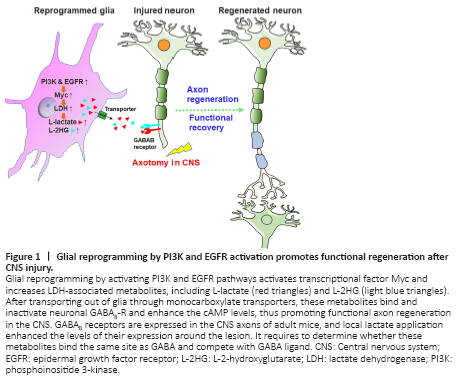神经损伤与修复
-
Figure 1|Glial reprogramming by PI3K and EGFR activation promotes functional regeneration after CNS injury.

Recently, an interesting study demonstrated the novel role of glia in regulating CNS regeneration. Reprogrammed glia by targeting their intracellular pathways, specifically PI3K and EGFR activation, stimulated significant axon regeneration after CNS injury. Enhanced production of glycolytic metabolites, including L-lactate and L-2-hydroxyglutarate (L-2HG), in reprogrammed glia, promotes dramatic axon regeneration by acting on neuronal GABAB receptors (Figure 1). This study reported the novel approach to promote neuronal regeneration and synaptogenesis by glial reprogramming and revealed innovative glia-neuron interactions coupled with glycolytic metabolites (Li et al., 2020a). Consistently, glia programming has been shown to improve regeneration of the retina neurons (Jorstad et al., 2020). Activation of the proneural transcription factor Ascl1 and its target genes (e.g., Apobec2a and Apobec2b) in Müller glia is required for axon regeneration after retinal damage in zebrafish, and overexpressing Ascl1 specifically in Müller glia combined with histone deacetylase inhibition enables Müller glia to generate retinal neurons after retinal injury in adult mice (Jorstad et al., 2017).